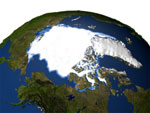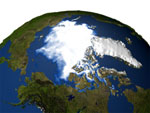|

Global Climate Change and Peak
Oil
The Sword of Damocles Has Two Edges
(Part I)
by
Dale Allen Pfeiffer
© Copyright 2004, From The Wilderness Publications, www.fromthewilderness.com. All Rights Reserved. May be reprinted, distributed or posted on an Internet web site for non-profit purposes only.
[Peak Oil is bringing on the
agonies of a huge cultural and economic transition.
Like the withdrawal symptoms endured by an addict,
the effects of the coming petroleum crisis will ravage
the American body politic and work necessary but painful
changes in the life of the entire human community.
Just as that inexorable withdrawal closes in on us,
we're acquiring a new awareness of the damage already
done by the petroleum addiction itself. Peak Oil is
the crisis of getting off petroleum; climate change
is the almost- irreversible legacy of two hundred years
of fossil fuel pollution. The difficult irony for the
United States – whose annual oil consumption dwarfs that
of any other nation – is that this day of reckoning comes
at a time when our political institutions are at their
worst levels of performance since the Civil War.
Corruption, income inequity,
narco-traffic, money-laundering, the warfare state,
loss of civil liberties, imperial overstretch, racism,
and the constant recourse to violence as a tool of
domestic and international policy – all
the ailments of the republic are interconnected. At their
center is an oil economy bound to militarism by the petrodollar
money system. Change that system, and the other problems
become far more amenable to rational reform – as Catherine
Austin Fitts has said, “until we change the way money
works, we will remain perpetual victims at the hands
of elites who have no incentive to change.”
Climate change should be that
missing incentive. Wealth and weapons are not much
use under seven meters of melted glacial seawater.
Still, the fake statesmen who profiteered from fifty
years of nuclear “Mutual Assured Destruction” are
unlikely to be moved by any amount of peril, so long
as they enjoy coercive economic and political power.
It seems the education of the public is the key to a
safer world – so we're educating each other. In part
one of this three-part story, FTW Science Editor Dale
Allen Pfeiffer sets out a detailed picture of the climate
change issue and its paramount importance. Part two will
consider the dreadful convergence of global climate change
and the peak of global oil production. – FTW]
APRIL 13, 2004 0800 PST (FTW) – In
October of 2003, the Pentagon published a report on abrupt
climate change.1 Its
authors were by Peter Schwartz, a CIA consultant and former
head of planning at the Royal Dutch/Shell Group, and Doug
Randall of the California-based Global Business Network.2 Their
task was to assess the likelihood of abrupt climate change
within the next twenty years. They were then supposed to
develop a scenario of the possible consequences should
abrupt climate change occur starting in 2004. Finally,
they were to make recommendations to the President based
on their study: An Abrupt Climate Change Scenario and
Its Implications for United States National Security.
A few copies were printed and circulated around the Pentagon,
which heavily censored the report and is now downplaying
its significance.3 It
remained effectively buried and all but forgotten until
copies were leaked to the media, first to Fortune
Magazine,4 and
then to The Observer.5 The
Pentagon has rightfully pointed out that this is a speculative
report; they are not expecting abrupt climate change to
begin in the year 2004. Schwartz and Randall are exploring
a risk scenario, such as the Pentagon and the CIA draw
up all the time – what would happen if the Russians launched
a nuclear attack this year; what would happen if California
suffered the big one, etc. But the real importance of the
report lies in the statement of probability and in the
authors' recommendations to the President and the National
Security Council.
While no statistical analysis of
probability is given in the report as it has been released
(any such statistical analysis would most likely be classified),
the authors state that “the plausibility of severe and
rapid climate change is higher than most of the scientific
community and perhaps all of the political community
is prepared for.”6 They
say that instead of asking whether this could happen,
we should be asking when this will happen. They conclude: “It
is quite plausible that within a decade the evidence
of an imminent abrupt climate shift may become clear
and reliable.”7
From such a shift, the report claims,
utterly appalling ecological consequences would follow.
Europe and Eastern North America would plunge into a
mini-ice age, with weather patterns resembling present
day Siberia. Violent storms could wreak havoc around
the globe. Coastal areas such as The Netherlands, New
York, and the West coast of North America could become
uninhabitable, while most island nations could be completely
submerged. Lowlands like Bangladesh could be permanently
swamped. While flooding would become the rule along coastlines,
mega-droughts could destroy the world's breadbaskets.
The dust bowl could return to America's Midwest. Famine
and drought would result in a major drop in the planet's
ability to sustain the present human population. Access
to water could become a major battleground – hundreds
of millions could die as a result of famine and resource
wars. More than 400 million people in subtropical regions
will be put at grave risk. There would be mass migrations
of climate refugees, particularly to southern Europe
and North America. Nuclear arms proliferation in conjunction
with resource wars could very well lead to nuclear wars.8 And
none of this takes into account the effects of global peak
oil and the North American natural gas cliff. Not pretty.
At the end of their report, Schwartz
and Randall advise that climate change “should be elevated
beyond a scientific debate to a US national security
concern.”9 And
while “alternative fuels, greenhouse gas emission controls,
and conservation efforts are worthwhile endeavors,” we're
urged to “prepare for the inevitable effects of abrupt
climate change -- which will likely come regardless of
human activity.”10
As stated, the Pentagon is playing down this report and
has opted not to send the authors' recommendations on to
the White House.
Urgent for humanity or not, this report is a major embarrassment
to President Bush and his corporate handlers, who remain
content to deny the reality of global climate change and
the validity of the overwhelming case for it. A phalanx
of corporate-sponsored disinformationists earns their keep
by deriding the report, wearing the mantle of scientific
authority while selling their intellectual souls. And the
mass media within the US have done their part by virtually
ignoring the story.
But outside the well-funded mental
playworld of Bush and his junk-science hirelings, what
is the global scientific consensus on abrupt climate
change? How real is global climate change, and what evidence
do we have for it? How could global warming result in
a miniature ice age in Europe and Eastern North America?
What are the differences among “accelerating
climate change,” “abrupt climate change,” and “runaway
global warming”? And how will Peak Oil and the North American
natural gas cliff affect global climate change? This article
tries to answer those questions, with some surprising results.
Global Warming
is a Reality
In 2001, no fewer than sixteen major academies of science
from throughout the world issued a statement which reads,
in part:
The work of the Intergovernmental
Panel on Climate Change (IPCC) represents the consensus
of the international scientific community on climate
change science. We recognize IPCC as the world's most
reliable source of information on climate change and
its causes, and we endorse its method of achieving this
consensus. Despite increasing consensus on the science
underpinning predictions of global climate change, doubts
have been expressed recently about the need to mitigate
the risks posed by global climate change. We do not consider
such doubts justified.
…we support the IPCC's conclusion
that it is at least 90% certain that temperatures will
continue to rise, with average global surface temperature
projected to increase by between 1.4 and 5.8ºC above
1990 levels by 2100.
It is now evident that human
activities are already contributing adversely to global
climate change. Business as usual is no longer a viable
option. … We urge everyone
- individuals, businesses and governments - to take prompt
action to reduce emissions of greenhouse gases. The balance
of the scientific evidence demands effective steps now
to avert damaging changes to the earth's climate.11
In their statement, the scientific academies
refer to a four-volume report released by the IPCC in 2001,
titled Climate
Change 2001.12 The
first volume focuses on the scientific case – a giant,
multifaceted, multidisciplinary edifice of peer-reviewed
empirical research and argumentation converging on a shared
set of conclusions. For instance:
Globally, it is very likely that the
1990s was the warmest decade and 1998 the warmest year
in the instrumental record, since 1861 (see Figure 1a).
New analyses of proxy data for the Northern Hemisphere
indicate that the increase in temperature in the 20th
century is likely to have been the largest of any century
during the past 1,000 years.
Satellite data show that there are
very likely to have been decreases of about 10% in the
extent of snow cover since the late 1960s, and ground-based
observations show that there is very likely to have been
a reduction of about two weeks in the annual duration
of lake and river ice cover in the mid- and high latitudes
of the Northern Hemisphere, over the 20th century.
There has been a widespread retreat
of mountain glaciers in non-polar regions during the
20th century.
Northern Hemisphere spring and summer sea-ice extent
has decreased by about 10 to 15% since the 1950s. It
is likely that there has been about a 40% decline in
Arctic sea-ice thickness during late summer to early
autumn in recent decades and a considerably slower decline
in winter sea-ice thickness.13

Variations in the Earth's
surface temperature over the last 140 years and the last
millennium. Taken from Climate Change 2001. http://www.grida.no/climate/ipcc_tar/
 
Arctic Sea
Ice 1979 — Arctic Sea Ice
2003
Taken from Recent
Warming of the Arctic May Affect Worldwide Weather.
NASA,
10/23/2003. http://www.gsfc.nasa.gov/topstory/2003/1023esuice.html
One of the most dramatic findings of the report concerns
the shrinkage of what had been permanent ice shelves inside
the Arctic circle. Satellite studies conducted by NASA
have shown more recently that Arctic perennial sea ice
has been decreasing at an average rate of 9% per decade.14 The
above satellite photos demonstrate just how dramatic this
retreat is. But its implications go far beyond the transformation
of the world's northern landscape. The inexorable melting
of sea ice could disrupt oceanic currents which help to
regulate and moderate the global climate, leading to abrupt
global climate change. These currents are absolutely crucial
to the familiar functioning of the biosphere and all its
ecosystems, including agriculture. But a major shift in
the convection currents of the world's oceans (the Gulf
Stream is the most famous) would make the Earth quite a
different world from the one to which civilization has
adapted. That will be the subject of this article's sequel.
Decreasing snow and ice cover leads
to further warming of the Earth's surface. Whereas black
objects absorb incoming electromagnetic energy, the bright
white snow and ice at the poles is an excellent reflector — so
light and heat from the sun bounce off the surface of
our planet and back into space (an effect known as albedo). As
global warming melts the polar snow and ice cover, the
Earth's albedo diminishes, allowing even more of the sun's
energy to be absorbed and retained by the Earth. This,
in turn, can lead to a further decrease in snow and ice
cover, resulting in a positive feedback loop which further
increases the effect of global warming.
Returning to the IPCC report, other
major observations include a rise in global average sea
level over the 20th century, and an increase in global
average ocean heat content measured since the 1950s.
Average rainfall has decreased in the mid-and higher
latitudes of the Northern Hemisphere during the 20th
century, at the same time that rainfall is likely to
have risen over equatorial land masses. Mid- and high
latitudes of the Northern Hemisphere have seen an increase
in severe weather, as well as an increase in cloud cover.
Since the 1950s, there has been a reduction in the frequency
of extremely low temperatures, and a smaller increase
in the frequency of extremely high temperatures. Episodes
of El Niño-Southern Oscillation phenomenon
are becoming more frequent, more persistent, and more intense.
And in some regions, particularly in Africa and Asia, the
frequency and intensity of droughts is increasing.15
The IPCC goes on to quantify the effect of human-induced
climate change. They note that the concentration of atmospheric
carbon dioxide has increased by 31% since 1750. The report
states that 75% of anthropogenic [human-induced] carbon
dioxide emissions over the past 50 years is due to fossil
fuel burning, with most of the remainder due to land-use
change and deforestation. Atmospheric concentration of
methane has increased by 151% since 1750, and atmospheric
concentration of nitrous oxide has increased by 17% since
1750.

Long records of past
changes in atmospheric composition
provide the
context for the influence of anthropogenic emissions.
(a) shows changes in the atmospheric
concentrations of carbon dioxide (CO2), methane
(CH4), and nitrous oxide (N2O) over the past 1000 years.
The ice core and firn data for several sites in Antarctica
and Greenland (shown by different symbols) are
supplemented with the data from direct atmospheric
samples over the past few decades (shown by the line
for CO2 and incorporated in the curve representing
the global average of CH4). The estimated positive
radiative forcing of the climate system from these
gases is indicated on the right-hand scale. Since these
gases have atmospheric lifetimes of a decade or more,
they are well mixed, and their concentrations reflect
emissions from sources throughout the globe. All three
records show effects of the large and increasing growth
in anthropogenic emissions during the Industrial Era.
(b) illustrates the influence
of industrial emissions on atmospheric sulphate concentrations,
which produce negative radiative forcing. Shown is
the time history of the concentrations of sulphate,
not in the atmosphere but in ice cores in Greenland
(shown by lines; from which the episodic effects of
volcanic eruptions have been removed). Such data indicate
the local deposition of sulphate aerosols at the site,
reflecting sulphur dioxide (SO2) emissions at mid-latitudes
in the Northern Hemisphere. This record, albeit more
regional than that of the globally-mixed greenhouse
gases, demonstrates the large growth in anthropogenic
SO2 emissions during the Industrial Era. The pluses
denote the relevant regional estimated SO2 emissions
(right-hand scale).
[Based upon (a) Chapter
3, Figure
3.2b (CO2); Chapter
4, Figure
4.1a and b (CH4) and Chapter
4, Figure
4.2 (N2O) and (b) Chapter
5, Figure
5.4a]
Graphs and caption taken from Climate Change 2001. http://www.grida.no/climate/ipcc_tar/
Understanding the science of climate change
involves learning a few key terms. Radiative forcing is
a measure of the influence a factor has in altering the
balance of incoming and outgoing energy in the Earth-atmosphere
system.16 It's
an index of the factor's importance as a potential climate
change mechanism. It is expressed in Watts (a unit of power,
or energy-per-second) per square meter (a unit of area
on the Earth's surface): Wm -2. According to Climate
Change 2001, radiative forcing due to increases in
greenhouse gases from 1750 to 2000 is estimated to be 2.43
Wm -2 overall: 1.46 Wm-2 from carbon dioxide, 0.48 Wm -2
from methane, 0.34 Wm -2 from halocarbons (chlorofluorocarbons
and similar gases), and 0.15 Wm -2 from nitrous oxide.
Overall mean radiative forcing is expected to increase
further over the next century even if emissions of greenhouse
gases decrease, due to the lifetime of present gases in
the atmosphere.
The report points out that newer and stronger evidence
has made it plain that most of the warming observable over
the past 50 years is attributable to human activities.
Ice core records from Iceland and Antarctica are widely
considered to have cinched the case for industrially caused
global warming. These ice cores have provided us with a
climate record stretching back over 1,000 years. Along
with new and more accurate models of climate variability,
the extended climate record indicates that the current
warming trend is unusual and unlikely to be entirely natural
in origin. Improved models of climate response to natural
and anthropogenic forcing consistently find evidence of
an anthropogenic signature in the climate record of the
past 50 years.
Contrary to the politically convenient
science preferred by the White House and the petroleum
executives who live there, simulation of climate response
to natural forcings alone – the much-vaunted variations
in solar irradiance and volcanic eruptions – do not explain
the warming in the second half of the 20th century. Natural
forcings are a contributing factor, but the current generation
of computational models can now correct for them effectively
(in other words, the new models take into account uncertainty
in the magnitude of modeled response to external forcing
due to uncertainty in climate sensitivity). Models are
becoming sufficiently sophisticated that they now accurately
model climate observations made over the last 140 years.
These models demonstrate that the estimated rate and magnitude
of warming due to increasing greenhouse gases alone is
sufficient to account for observed warming.17
Stepping away from the IPCC report, we can find an abundance
of evidence supporting global climate change from scientific
institutions throughout the world. Seasons and weather
patterns are changing; glaciers are retreating; the continental
ice sheets of Antarctica are beginning to break up; permafrost
in the upper latitudes of North America and Siberia is
thawing; the Inuit people of the far north are finding
that their traditional lifestyles are endangered by shortened
winters and ice flows which are breaking up sooner; islands
of Polynesia and elsewhere are being submerged by rising
water levels; tundra flora is receding; and subtropical
flora and fauna are moving into temperate latitudes.
In December 2003, the World Health Organization announced
that global warming is killing an average of 150,000 people
per year.18 Global
warming is contributing to increases in malaria and other
insect-borne diseases, malnutrition and pollution-related
diseases, and extreme weather events such as the deadly
2003 summer heat wave in Europe. A recent issue of the
journal Nature contained a report signed by numerous
prominent scientists warning that as much as one quarter
of the animal species on the planet will be threatened
with extinction in the next 50 years due to global climate
change.19
The economic toll is already considerable; global climate
change is now costing the world economy billions of dollars
annually. The UN estimates this cost at over $60 billion
for 2003 alone, a year of climate change induced disasters
such as the killer heat wave in Europe and the massive
flooding in China.20 And
a group of insurers led by Munich Re has reported to the
UN that global climate change could cost the world over
$300 billion per year by 2050.21
Meanwhile, a report issued by the German Advisory Council
on Global Change has stated that measures to curb greenhouse
gas emissions must be at least four times stronger
than the Kyoto Protocol if they
are to prevent melting of the polar ice caps.22 The
Council warns that there is only room for another 1.4ºC
of global warming before dangerous climactic changes become
probable. The global mean temperature has already risen
0.6ºC since the beginning of the industrial era, so
this places the danger threshold at an average global increase
of 2ºC, which the Council warns will be exceeded within
this century if we do not pursue stringent climate protection
policies. Although the Kyoto Protocol is not sufficient
to prevent disaster, it would be a first step.
Yet the Kyoto Protocol now appears to be dead in the water.
The Russians have followed the US lead in walking away
from the protocol because they believe its measures would
damage economic growth.23 Between
the American culture of fossil fuel addiction and the capture
of Congress by corporate money, Kyoto never had a chance
in the US Senate. For the moment, then, the struggle to
slow and reverse these disastrous climatic trends must
proceed from inside the collective insanity of our global
economic system.
Yet the risks are much greater than even the sources quoted
here have allowed, as will become apparent when we discuss
the possibilities of abrupt climate change and runaway
climate change, and when we look at how the global oil
peak and the North American natural gas cliff could affect
global climate change.
1 An Abrupt
Climate Change Scenario and Its Implications for United
States National Security, Schwartz,
Peter, and Randall, Doug. October, 2003. http://www.heatisonline.org/contentserver/objecthandlers/index.cfm?id=4591&method=full
2 Now the
Pentagon tells Bush: climate change will destroy us, Townsend,
Mark, and Harris, Paul. The Observer, 2/22/2004. http://www.guardian.co.uk/climatechange/story/0,12374,1153530,00.html
3 Pentagon
downplays report on climate change that it commissioned. AFP,
2/24/2004. http://story.news.yahoo.com/news?tmpl=story2&u=afp/us_environment_climate
4 Climate
Collapse; The Pentagon's Weather Nightmare, Stipp,
David. Fortune Magazine, 1/26/2004.
5 Op. Cit. See note
2.
6 Op. Cit. See note
1.
7 Ibid.
8 Ibid.
9 Ibid.
10 Ibid.
11 The
Science of Climate Change. 5/17/2001. http://www.royalsoc.ac.uk/files/statfiles/document-138.pdf
12 Climate
Change 2001, The Intergovernmental Panel on
Climate Change. Cambridge University Press, 2001. http://www.grida.no/climate/ipcc_tar/
13 Ibid
14 Recent
Warming of the Arctic May
Affect Worldwide Climate, Goddard Space Flight
Center. NASA, 10/23/2003. http://www.gsfc.nasa.gov/topstory/2003/1023esuice.html
15 Op. Cit.
16 “Radiative
forcing is defined as a change in average net radiation
at the boundary between troposphere and stratosphere (known
as the tropopause). A positive radiative forcing tends
on average to warm the surface; there is a net heat flow
from troposphere to stratosphere. A negative forcing on
average tends to cool the surface; there is a net heat
flow from stratosphere to troposphere.” See ‘Alternatives
to Traditional Transportation Fuels 1994, Volume 2, Greenhouse
Gas Emissions; Appendix A, The Chemistry and Physics of
Global Warming: An Overview.' http://www.eia.doe.gov/cneaf/pubs_html/attf94_v2/appd_a.html
17 Ibid.
18 Global
warming kills 150,000 people a year, warms UN, Kirby,
Terry. The Independent, 12/12/2003. http://news.independent.co.uk/world/environment/story.jsp?story=472452
19 Extinction
Risk from Climate Change, Thomas, Chris D.,
et al. Nature, Vol. 427, 1/8/2004. http://www.med.harvard.edu/chge/extinctions.pdf
20 Climate
change ‘cost $60b' in 2003. CNN, 12/11/2003. http://www.cnn.com/2003/WEATHER/12/11/un.climate/
21 Impact
of climate change to cost the world $US 300 billion a
year. United Nations Environmental Programme,
2/3/2004. http://www.unep.org/Documents/Default.asp?DocumentID=192&ArticleID=2758
22 Climate
Protection Strategies for the 21 st Century; Kyoto and
Beyond. German Advisory Council on Global Change.
WBGU, 2003. http://www.wbgu.de/wbgu_sn2003_engl.html
23 Russia: Kyoto pact
harms economy, Reuters. CNN, 12/2/2003. http://www.cnn.com/2003/WORLD/europe/12/02/russia.kyodo.reut/

New "Must Reads"!
Who are the CFR? Trilateral Commission?
The Bilderbergs?
Find Out Now BEFORE the Elections!
 
http://www.fromthewilderness.com/store/books.shtml
|